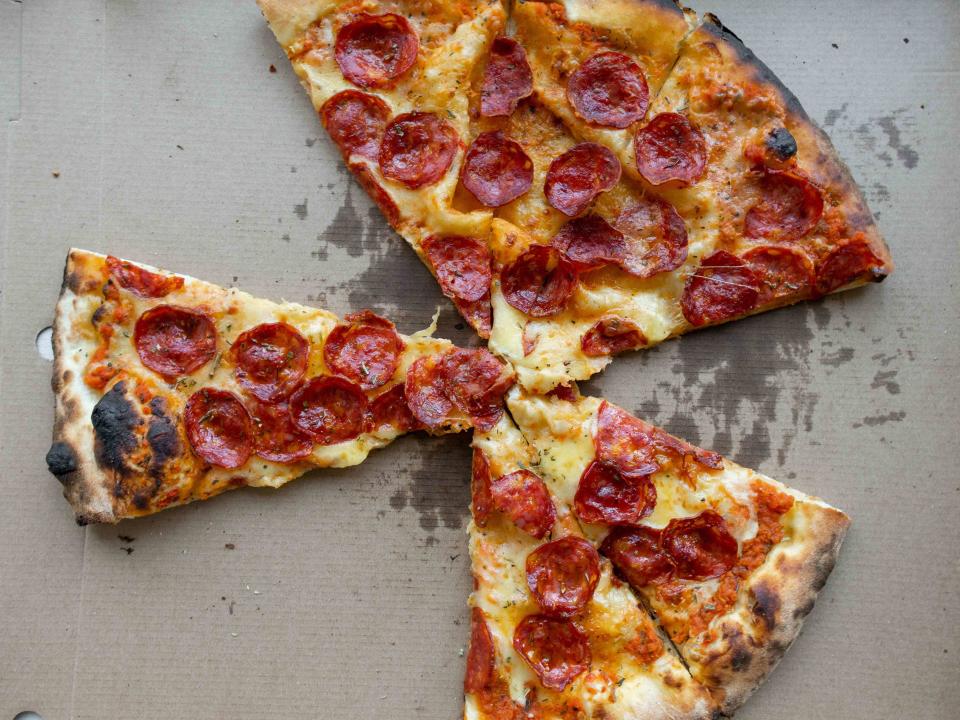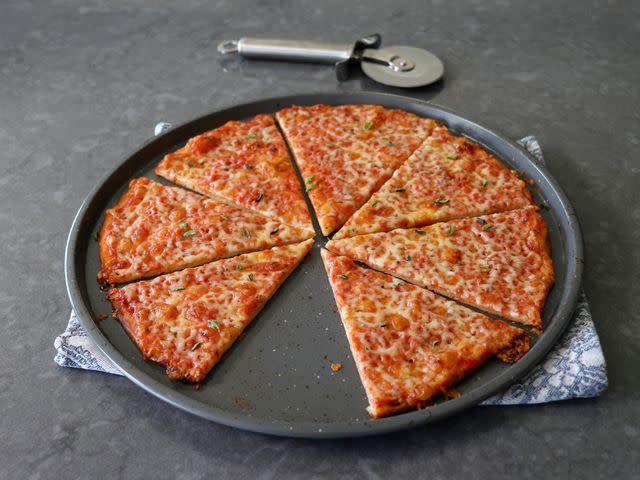Here’s Why You Should NEVER Let Your Pizza Sit Out Overnight
Follow these storage tips to keep your leftovers safe and delicious.

Aleksandr Zubkov/Getty Images
Leftover pizza for breakfast is truly one of life’s simple pleasures. However, a delicious leftover breakfast can be dangerous if stored incorrectly. We’ve all eaten food that may have been out for a questionable amount of time, but how long can pizza really sit out before it’s beyond questionable and just plain dangerous?
How Long Can Pizza Sit Out?
From the time it’s done cooking, pizza can sit out for up to two hours. All perishable foods adhere to the same food safety guidelines. The health code stipulates these guidelines for restaurants, but the rules are the same to keep food safe at home. After cooking, the food starts to cool. I
n restaurants, this temperature window is often called “the danger zone.” It got this name because between 41 degrees F and 141 degrees F is the optimum window for dangerous bacterial growth. Bacteria growth means spoiled food, stomach aches, and sometimes worse. Food safety rules say that food can only be kept in this temperature range for two hours. After that, food in the danger zone can become dangerous to eat.

Can You Leave Pizza Out Overnight?
Unless you’re sleeping for one hour and 59 minutes, no, pizza cannot be left out overnight. Since it’s perishable and contains ingredients with low thresholds for bacterial growth, such as cheese, tomato products, meat, and cut veggies, it must be taken out of the danger zone after two hours. After eight hours or more, your pizza will be teeming with bacteria.
What Happens If You Eat Pizza That Sat Out Overnight?
For some people, absolutely nothing happens after eating danger-zone pizza. But all it takes is one bad pizza to make you seriously ill. Food poisoning is no joke: 48 million people get sick from food-borne illness each year, and about 3,000 die from it.
Bacteria like salmonella, E. coli, campylobacter, and listeria can grow on pizza while you sleep. It's possible that only some will grow, and maybe you’ll just have a mild stomach ache, but ingesting even a small amount of spoiled food is bad for your digestive system.
Beyond a serious stomach ache, other gastrointestinal distress is common, and some people can experience dehydration so severe that it requires hospitalization. Flu-like symptoms like fever, chills, vomiting, and sweating can also result from food poisoning, which might make you think you have a cold when bad leftovers are the real culprit.
Children, older people, and those with compromised immune systems are most susceptible to the effects of bacteria that grow on food, but none of us are immune. If running to the bathroom all day isn’t your idea of a fun after-breakfast activity, it’s best just to throw away that pizza that’s been on the counter since last night.

Chef John
How to Store Leftover Pizza
Once you’re done eating and before the two-hour mark, move the leftover slices out of the box and into a clean container like a plastic tub with a snap-on lid or wrapped tightly in plastic or aluminum foil.
The rules are the same for homemade pizza: Store it in a separate container from what it was baked in. Keep it in the fridge, and if you change your mind and want seconds before it’s been refrigerated for 6 hours, make sure to heat it again, as it could still be cooling and in the danger zone.
If it’s been over 6 hours, you’re in the clear to eat it cold. Stored safely, pizza can be eaten for up to 4 days. Leftover pizza can be frozen, but if you have extra ingredients, you’re better off freezing the dough and toppings separately before cooking, as frozen and reheated pizza doesn’t have the best texture.
How to Reheat Leftover Pizza
So you’ve successfully cooled and stored your pizza and are ready for the reward of leftovers. You can eat it cold or heat it up and out of the danger zone. The great news is that most heating methods can easily get you there.
The easiest way to reheat pizza is to pop it in the microwave with a mug of water in 30-second bursts until it’s hot all the way through; just know that the microwave can make pizza soft and soggy. In the air fryer, preheat to 350 and cook for 3-5 minutes, checking to make sure the pizza is hot all the way through. Check often; air fryers can quickly burn the outside before the inside is heated. If you have a little more time, preheat the oven to 375 degrees F and cook the pizza on a foil-lined tray for about 10 minutes.
The best way to reheat your pizza quickly and safely without making any concessions on texture is in a pan on the stove: Preheat a nonstick pan over medium-low heat. Once it’s hot, place your pizza in the pan and let it cook for a few minutes until the bottom is crisped up. Increase the heat to medium, then carefully pour one to two tablespoons of water into the pan and quickly cover it with the lid. The water should immediately bubble up and create steam, melting the cheese while the bottom stays crisp.
After about 3 minutes, your pizza should be perfectly reheated.
Read the original article on All Recipes.

